
The Family Album Pages:
These family album pages show pictures from the daily lives of the internees, in both the Canadian and
American camps. In a variety of ways cameras were brought in the camps, loaned out to friends, film
processed, and the rituals of daily life were preserved.
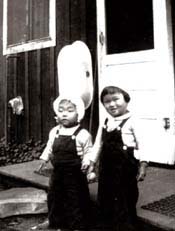
During the coarse of working on this project, Hayashi traveled to photograph each camp site, and also attended reunions and conferences for the camp survivors and their relatives. She came into contact with internees and their relatives, many of whom had collected and saved fascinating albums of photographs from the time that they were interned. This exhibit, curated by Masumi Hayashi, is a small sampling of those memories. (Please download the individual internee's photo album pages.)
These web site pages, and the 1996 exhibition of these photographs, document the human experience are part of the memory of dislocation and transition.
|
Professional Photographers |
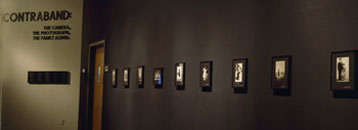 |
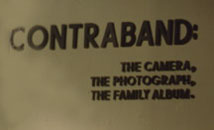 |
|
Cleveland State University Art Gallery, March 1996. |
|
|
The camera was considered contraband for the internees during the incarceration, since they were considered enemy aliens. Cameras were mainly of two types: the amateur box camera, a "point and shoot" type, and a more complex camera with f-stops and shutter speeds for the more serious amateur. The photographer who owned the cameras or parts of the cameras, which were considered contraband, were either serious amateurs or professionals. Photographers who were taking pictures of relocation camp life were either: The content of photographs for mass distribution was restricted to what mass media editors or the government wanted to show. Many internee photographers documented their personal life as well. The photographs included in this web site were taken by the internees, sometimes just after they were recently released either on work release or as soldiers to fight in WWII. There are times when snapshots and family album photographs go beyond the common ritual. Ironically, Kodak with its "you take the picture, we do the rest." mail order marketing strategy made it possible for the uncommon event of incarceration of the Japanese American family to be recorded. These photographers exist as the witness and they provide us with this reconstruction of that history and that cultural phenomenon. THE INTERNEE AS OFFICIAL CAMP PHOTOGRAPHER. The official camp photographers were internees who were amateur or professional photographers previous to being interned. Official camp photographers became more common around 1943, about a year after the camps were started. They functioned as school photographers, official government photographers, and portrait photographers in the camps. Many camps only had camp photographers. TOYO MIYATAKE , born 1895, Japan; died 1979, Los Angeles. Interned at Manzanar Relocation Camp. Before the war, Miyatake had a commercial photo studio in Little Tokyo in Los Angeles. He had studied with Edward Westin and won many photography awards. Miyatake realized that cameras were contraband but was able to get his camera lens pass the guards and inspections. While in Manzanar, he had the carpenter build a light tight box for his lens and sent his negatives to photography friends on the outside to get developed. Edward Weston was a friend whose photographs he helped sell to the Japanese American community before the war. Westin's recommendation to the camp director helped gain his confidence and he became the camp photographer. He was eventually able to practice his craft more openly. Information and photographs are from his son, Archie Miyatake.
Fukuyama was a serious amateur photographer before the war and had won a Kodak award in photography in 1932. There is little information about his life as a photographer in the camps. How he got his cameras into the camps, how he got his film developed and printed before he became camp photographer is not known. He originally lived in Los Angeles and returned to L.A. after the camps. JAMES YONEMURA , Interned at Heart Mountain Relocation Camp. Little is known about this camp photographer. Relatives were not found for information. Information and photograph (the wedding) are from Grace and Ed Akiya.
THE INTERNEE / AMATEUR PHOTOGRAPHER. Most internees documentated their lives just as most people want some documentation of their existence, whether it be day to day life or special family rituals. The pleasures of being photographed and to photograph is universally common The desire to document our existence through the photograph is as strong in our psyche as producing progeny. there is a need to create this reality for posterity through snapshots and the family album. With the camp regulations on contraband this idea of the family photograph had became illegal at most camps. This repression of the camera and the family photograph helped keep and maintain this family secret of internment life and created a caste of shame and guilt on this passage. Within all the ten relocation camps, cameras were considered contraband and confiscated. Exceptions to the rule happened, and a few internees managed to bring their cameras in with them. Heart Mountain Relocation Camp seemed to be an exception, as there were several family albums being passed around during the 1995 Heart Mountain conference and the Gila River relocation camp reunion. In 1943, the illegality of taking snapshots at Heart Mountain was relaxed and camp officials allowed cameras and photographs. This seemed to be unique to one or two of the camps out of the ten camps. As the end of war seemed evident, the security involving both movie cameras and still cameras became more and more relaxed. The government became more focused on the transformation of the internee to fit into normal American live and to live within the free American community.
Mrs. Akiya purchased her Kodak box camera for $4.98 in Los Angeles before the war. When she packed for evacuation it was in the bottom of her duffel bag and she had forgotten about it. As she went through inspection at Assembly Center the guard either did not see the camera or let it pass through. She had forgotten she had it in the bag but was thankful later she did unconsciously bring it. She had a friend in L.A. who would send her film and who would have her prints processed and printed. She photographed her sisters, brothers, family members, and friends and babies. She and her husband, Ed Akiya, were married in camp and the camp photographer, James Yonemura took a makeshift wedding photograph for them. She shares her family album with her children and grandchildren in Cleveland. Mrs. Grace Akiya is a fourth degree blackbelt in judo, and teaches on Tuesdays and Thursdays at the Mideast Judo Academy. She is 80 years old.
Mrs. Morioka immigrated to San Francisco, California, when she was four years old. She was living in Hollywood, California, and working as an extra for MGM studios when she was evacuated. She was a classical singer and ballet dancer. Her parents were deceased. She brought in with her a momento from her father, a folding Kodak camera, which she was able to pass through the guards and inspections at Santa Anita Assembly Center and at Heart Mountain. Restrictions became more lenient. She was notable to get film or processing until she got to the Heart Mountain Relocation Camp. Montgomery Wards sent catalogues to the internees and she was able order film and processing through mail order. The photographs she took were of other mothers and their children, friends, and extended family such as soldiers going off to fight in Europe, people who were part of the Hawaiian band her husband played for in the camps. She was the hula dancer in the band. Both she and her husband had no immediate family in the camps. She shares her family album with her daughters and grandchildren in Hawaii. Her daughter, Lani Sanjek, introduced me to her family album of camp photographs at the 1995 Heart Mountain Conference and reunion. EVA HASHIGUICHI , born 1925, Clarksburg, California, and resettled in Cleveland, Ohio. Interned in Heart Mountain Relocation Camp. Mrs. Hashiguichi accidentally brought in her the Kodak box camera she received as a gift on her sixteenth birthday. It was confiscated at the Fresno Assembly Center by the guards during inspection. Her brothers were sent out to Jerome Relocation Center to do construction work on that camp and were able to retrieve the numerous contraband items taken from them, like knitting needles, scissors, and her camera. At the Jerome Relocation Camp, she was able to get film and get processing at the canteen. She also used the camp photographer's service of processing and prints. The photographs she took reflected her interests in team sports as she took numerous group snapshots of various sports teams organized in the camps. Mrs. Eva Hashiguichi is active with tennis and bridge and spends most of her free time with her grandchildren. She is 72 years old. TOKUYE SATO , born unknown, resettled in Los Angeles. Interned in Topaz Relocation Camp. Tokuye Sato was released to work as a carpenter from Topaz Relocation Camp in 1943. He had a friend buy a Contax 35mm camera for him and he would bring it in when he visited his mother in the camp. When he was assigned to the construction crew of the Topaz camp hospital he would develop his film at the hospital's x-ray darkroom. His camera was confiscated once when entering the camp and he was held by the FBI for a brief time. His camera was returned to him when it was discovered he was only photographing friends and family. Visitors were allowed to bring cameras in, but for the internees it was considered contraband at Topaz. The curious thing about this photographer was his patience. He saved his film, until he took a photography course at South West College in L.A.in 1987, ten years ago. He waited 40 years to see what the prints looked like. Sato's snapshots represent a range of interests but one of the more recurring reflects his interest at the time and most of the images are of teenage girls in various postures of giggling. Ms. Jane Beckwith of Delta, Utah, introduced me to Sato's photographs when I was photographing Topaz Relocation Camp in 1995.
VISITORS WITH CAMERAS. Minidoka Relocation Camp . This photograph of Shim Yamamoto's mother, Shigeyo Yamamoto, was taken on the doorstep of the barracks by a visitor to the camps who had a camera. Shim's sister, Mary Nakanishi, said it was a soldier visiting his parents who took this snapshot and she does not remember who it was. Visitors were allowed to bring cameras in but for the internees still in the camps it was considered contraband at Minidoka. Shim Yamamoto resettled in Cleveland, Ohio, in 1943, on a work release program. His mother and sister joined him in Cleveland in 1945. Shim Yamamoto moved to Seattle in 1995 and writes articles for the Cleveland JACL newsletter. Amache Relocation Camp (Granada). Tayeko Nomura was interned at Granada Relocation Camp in Colorado. She married Tayeko Nomura in camp and they resettled nearby Las Cantinas in Colorado as farmers. She showed me these camp snapshoots that she kept in a shoebox with other small keepsakes of that time. Mrs. Tayeko Nomura does not remember who took the photos nor many of the internees in the photos. Mr. Emery Nomura was in the hospital at time of the interview and visit. The Granada high school history teacher, John Hooper, referred me to Mr. and Mrs. Nomura. He has a Granada high school class on the history of the Amache Internment camp where the students study the archeology/history of the site and the stories of the internees (met during reunions). They will have a website soon.
THE JAPANESE CANADIAN INCARCERATION "FAMILY ALBUM" The Canadian government also incarcerated their citizens with Japanese ancestry during WWII. They were incarcerated in wider range of camps, "self supporting camps", labor camps, "road camp projects", and "prisoners-of-war" camps. 21,460 Canadians of Japanese ancestry were incarcerated and not allowed to return to the west coast until 1949. Some were forced to relocate to a Japan they never knew (repatriates) and others were forced to relocate inland and eastern Canada. The need to record and document the family and their riturals was evident in these times of dislocation and transition. These photos were kept in family albums. The following are family album pages from the Japanese Canadian story, photographs taken by the Japanese Canadians interned with contraband caneras.
Midge Ayukawa
,
born in Vancouver, B.C., Canada. Interned at Lemon Creek Internment
Camp in the Mrs. Midge Ayukawa borrowed a friend's box camera to photograph her family in Lemon Creek Internment Camp before they left. Some of these other photographs were bought from the camp photographer to remember the experiences and memories. One of her girlfriends' father was an amatuer photographer in camp and recorded a number of activities of the growing children's camp life.
Irene Tsuyuki
,
born in Vancouver, B.C., Canada. The family album photographs are by her husband, Norman Tsuyuki, who is an avid photographer and was interned on a farm with his family in Lillooet, a "self-supporting camp." There were less restrictions in the self-supporting camps but they were still isolated in the interior mountains of British Columbia.
|
|
About the exhibition: |
This exhibition was curated by Professor Masumi Hayashi and exhibited at the Cleveland State University Art Gallery in Cleveland, Ohio, in March/April 1996. Special thanks for support and advice of the Cleveland Japanese | American Citizens' League and Hank Tanaka and all the gracious people who participated with their family photographs. All photographs are copyrighted. Reuse is subject to copyright laws and permission of the collectors and their families. |
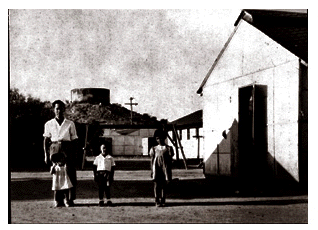
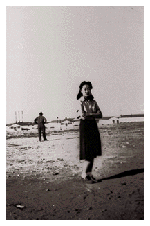
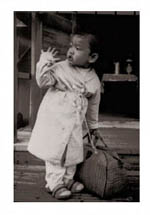
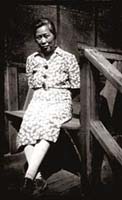
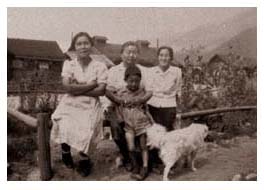 Slocan
Valley, resettled to Hamilton, Ontario, Canada, where she went to
high school. She now lives on Victoria Island, B.C., Canada. Mrs.
Ayukawa has completed a doctorate in history (1997) and has a doctorate
in chemistry and writes articles for "The Bulletin" in
Vancouver.
Slocan
Valley, resettled to Hamilton, Ontario, Canada, where she went to
high school. She now lives on Victoria Island, B.C., Canada. Mrs.
Ayukawa has completed a doctorate in history (1997) and has a doctorate
in chemistry and writes articles for "The Bulletin" in
Vancouver.
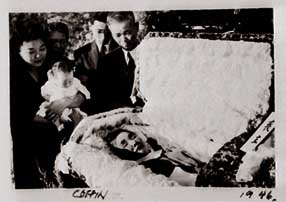 Interned
at Tashme Internment Camp, British Colubia, Canada. Resettled in
Richmond, near Vancouver. At the end of the internment in 1946,
Ms. Tsuyuki's adopted parents were repatriated to Japan. The Tsuyuki
family sponsored her return to Canada where she married her husband,
Norman Tsuyuki, the son, and raised her family on a Richmond farm
in B.C. Her parents died in Japan as she was processing their re-entry
back to Vancouver. Because of the separation by repatriation she
never saw her parents again.
Interned
at Tashme Internment Camp, British Colubia, Canada. Resettled in
Richmond, near Vancouver. At the end of the internment in 1946,
Ms. Tsuyuki's adopted parents were repatriated to Japan. The Tsuyuki
family sponsored her return to Canada where she married her husband,
Norman Tsuyuki, the son, and raised her family on a Richmond farm
in B.C. Her parents died in Japan as she was processing their re-entry
back to Vancouver. Because of the separation by repatriation she
never saw her parents again.

